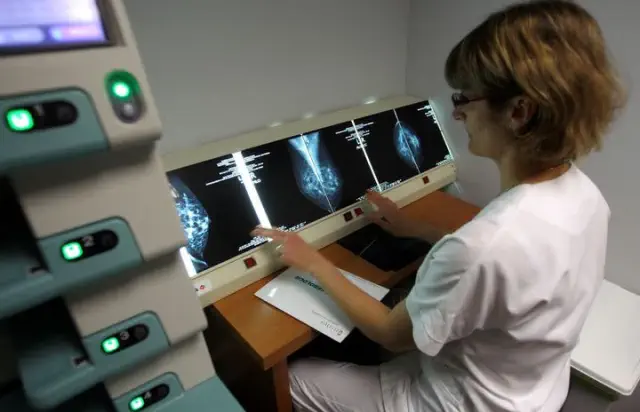
A lesser-known indication of Alzheimer's disease may manifest in your walking pattern.
Researchers discovered that examining patients' movements could effectively recognize '60% of all types of dementia'. View pictures in App save up to 80% data. A study conducted in 2019 revealed significant variations in walking patterns among individuals diagnosed with various forms of dementia. Scientists have said how a person moves around could potentially lead to an Alzheimer's diagnosis. Pioneering research, led by Newcastle University, sought to improve existing methods used to diagnose different variants of the cognitive health condition. This task focused on differentiating between Alzheimer's disease, which is the most prevalent type of dementia, and Lewy body dementia (LBD). Individuals with Alzheimer's typically show more pronounced memory deficits in the initial phases of the condition; however, their symptoms can frequently be mistaken for those of LBD, leading to potential mismanagement of treatment. But in 2019, scientists found that analysing patient movements could accurately identify '60% of all dementia subtypes' in a remarkable first. At the time, Dr Ríona McArdle, lead researcher at Newcastle University’s Faculty of Medical Sciences, explained: "The way we walk can reflect changes in thinking and memory that highlight problems in our brain, such as dementia. View pictures in App save up to 80% data. The study examined the walking patterns of 110 individuals, comprising 36 diagnosed with Alzheimer's, 45 with Lewy Body Dementia (LBD), and 29 individuals with normal cognitive function. "Accurately determining the specific type of dementia a person has is crucial for both healthcare professionals and researchers, as it enables patients to receive the most suitable treatment tailored to their needs at the earliest opportunity. The findings from this research are promising, indicating that walking may serve as a valuable addition to the diagnostic resources available for dementia." "It is a key development as a more accurate diagnosis means that we know that people are getting the right treatment, care and management for the dementia they have." The study examined the walking patterns of 110 individuals, comprising 36 diagnosed with Alzheimer's, 45 with Lewy Body Dementia (LBD), and 29 individuals with normal cognitive function. A significant finding was that individuals with LBD exhibited greater changes in their walking patterns and displayed 'asymmetrical' movements, in contrast to patients with Alzheimer's disease. Estimates suggest that more than 944,000 people in the UK have dementia, including one in every 11 over 65 years old. LBD is thought to account for just 100,000 of these cases, according to Alzheimer's Research UK. In light of the findings, Dr James Pickett, Head of Research at Alzheimer’s Society, also previously added: "In this well conducted study we can see for the first time that the way we walk may provide clues which could help us distinguish between Alzheimer’s disease and Lewy body dementia. View pictures in App save up to 80% data. Research indicated that individuals with LBD exhibited changes in their walking patterns, demonstrating a greater degree of asymmetry in their movements. "This study, supported by the Alzheimer’s Society, is groundbreaking in the field of dementia research. It holds potential for developing a new method to effectively diagnose various forms of dementia." "Research holds the key to overcoming dementia and offers essential assistance to the 850,000 individuals currently affected by the condition in the UK. It is crucial that we persist in backing such promising research initiatives." "We anticipate the emergence of more extensive and prolonged studies to confirm this method and illuminate the connection between an individual's walking pattern and the diagnosis of dementia." NHS' list of potential early stage dementia symptoms Difficulty concentrating and planning tasks Sudden changes in personality or mood Confusion and memory loss Trouble finding the right words to say and not being able to understand conversations The health organization advises: "If you notice that someone you care about is becoming more forgetful, suggest that they visit a general practitioner to discuss the initial indicators of dementia. It's important to note that memory loss can stem from various other causes as well." "Nevertheless, if dementia is detected at an early stage, it may be possible to slow its progression in certain instances, allowing the individual to preserve their cognitive abilities for an extended period."

The functional analysis of genetic variants enhances the evaluation of cancer risk and informs treatment strategies.
Findings from a multi-institutional, international study led by researchers from the Mayo Clinic Comprehensive Cancer Center have significantly advanced the understanding of genetic alterations in the BRCA2 gene, a key player in hereditary cancer risk. The researchers completed a comprehensive functional assessment of all possible variants within the crucial DNA-binding domain of BRCA2, resulting in the clinical classification of 91% of variants of uncertain significance (VUS) in this part of the gene. This finding dramatically improves the accuracy of genetic testing and will allow healthcare professionals to offer more precise risk assessments and personalized treatment plans for people carrying these variants. The study, published in Nature, utilized CRISPR-Cas9 gene-editing technology to analyze the functional impact of almost 7,000 BRCA2 variants, definitively identifying those that increase cancer risk and those that do not. This new information will eliminate much of the uncertainty surrounding VUS, allowing for more informed decisions regarding cancer screening, preventive measures and treatment strategies. "This research is a major advancement in understanding the role of many BRCA2 variants in cancer predisposition," says Fergus Couch, Ph.D., the Zbigniew and Anna M. Scheller Professor of Medical Research at Mayo Clinic. Up until now, individuals with Variants of Uncertain Significance (VUS) frequently experienced anxiety regarding their potential cancer risk. However, with the recent classification of these variants, we can now offer a more definitive assessment of cancer risk, allowing us to customize prevention approaches and breast cancer treatments to better suit individual needs. Fergus Couch, the Zbigniew and Anna M. Scheller Chair in Medical Research at the Mayo Clinic. The findings have immediate implications for genetic testing laboratories and healthcare professionals, aiding them in offering more precise and personalized care to patients with VUS. Many people with VUS may be notified about the reclassification of their VUS as the ClinVar BRCA1/2 expert panel and testing laboratories use the new information in testing reports and updates. In addition, this new insight will aid in identifying patients with breast, ovarian, pancreatic or prostate cancer who might benefit from targeted therapies such as PARP inhibitors. Dr. Couch states, "We currently possess a comprehensive catalog of all potential VUS in this region of BRCA2, which can assist in directing clinical care." According to the researchers, this study establishes a foundation for upcoming research aimed at characterizing and classifying all BRCA2 variants across various populations and cancer types, thereby enhancing risk assessment for all individuals. The research was conducted in collaboration with Ambry Genetics Inc., Duke University, H. Lee Moffitt Cancer Center, the University of Pennsylvania, and various studies from the CARRIERS consortium. Financial support for the study came from the National Cancer Institute, the Mayo Clinic Breast Cancer SPORE (P50 CA116201), the R35 Outstanding Investigator Programs, the Mayo Clinic Comprehensive Cancer Center, and the Breast Cancer Research Foundation. For a full list of funding, disclosures and contributing authors, see the paper.

Enhance Your Restaurant's Exposure: Collaborate with the Atlanta Braves
View pictures in App save up to 80% data. The Atlanta Braves are transforming the way local eateries enhance their presence, providing an exceptional chance for food establishments to flourish. Through partnerships with this cherished sports franchise, restaurants can engage with a wide-ranging audience, greatly boosting customer visits. It's not solely about baseball; it's also a celebration of food. The initiative highlights restaurants from the southeastern region at Truist Park, transforming the space into a food lover's paradise. This approach not only boosts a restaurant's brand recognition but also connects with a community excited to discover local tastes. The fusion of regional pride and sports passion fosters a lively environment that is advantageous for both patrons and restaurant proprietors. Community Involvement Joining the Braves' initiative not only associates your restaurant with a well-respected local organization but also highlights your dedication to the community. By inviting fans into your venue, you build a bond that goes beyond just game days. This partnership could lead to loyal customers who value the backing of local businesses linked to their beloved team. A Fresh Culinary Exhibition Truist Park serves as a haven for food lovers. On game days, it evolves beyond a mere baseball venue, becoming a celebration of the diverse culinary offerings from the southeastern area. Restaurants participating in this effort gain increased visibility, allowing sports fans to explore fresh dining choices before or after the game. This fosters ongoing support, transforming occasional visitors into dedicated patrons who come back for the delightful experience. Opportunities in Strategic Marketing The collaboration presents various marketing possibilities that reach far beyond the stadium. With the Braves boasting a loyal fanbase, your restaurant can leverage extensive promotional channels. Consider the advantages of featuring your brand in game day programs, receiving social media mentions, and hosting interactive contests that motivate fans to enjoy a meal before supporting their team. Additionally, leveraging digital platforms and social media enables restaurants to reach a broader audience. By sharing captivating content, enticing visuals, and exclusive offers, establishments can boost their online visibility. This approach not only raises awareness but also fosters greater interaction, appealing to customers who value dining experiences tied to their recreational pursuits. Economic Consequences Partnering with the Atlanta Braves is not just a smart marketing strategy; it’s a wise financial decision as well. Restaurants participating in this initiative benefit from a significant boost in sales, especially during game days when customer foot traffic surges. With fans heading to the ballpark, many opt to dine at nearby establishments, which can greatly improve your profits. This campaign seamlessly integrates your restaurant into the game day experience, enriching the enjoyment for fans and simultaneously increasing your revenue. Enhancing Culinary Traditions The Atlanta Braves' initiative is crucial in strengthening the local food culture. The South is celebrated for its rich culinary heritage, and by merging local flavors with the excitement of sports, this partnership enhances the reputation of dining in the region. It establishes the South as not only a destination for outstanding sports but also as a vibrant culinary hub worthy of acclaim. Creating Distinctive Experiences This collaboration opens the door to crafting distinctive experiences that encourage repeat visits from customers. Imagine organizing events like 'Taste of the Braves' evenings, where fans can sample a variety of local cuisines in a lively and enjoyable setting. Introducing exclusive game day menus with standout dishes can attract patrons eager for the match to begin. This fosters a vibrant community vibe, positioning your venue as a favorite destination. Sustained Brand Commitment The importance of loyalty cannot be emphasized enough. As the restaurants involved integrate into the Braves' culture, they are more likely to draw in customers who will champion their culinary identity. Passionate fans frequently look for genuine ties to the teams they support, and joining this initiative establishes your restaurant as a key element in fostering those relationships. Making Use of Regional Produce Additionally, collaborating with the Braves promotes a focus on using local ingredients. By featuring seasonal and locally-sourced produce in your menu, you can increase the attractiveness of your dishes to health-minded diners. Emphasizing local sourcing creates a compelling story for your restaurant, demonstrating a dedication to sustainability and aiding other businesses within the community. Final Thoughts: What to Do Next Capitalizing on the chance to collaborate with the Atlanta Braves is not merely a strategic decision; it's crucial for restaurant owners who wish to excel in a competitive market. This partnership offers a distinctive opportunity for local eateries, enhancing their exposure and reinforcing their role as vital components of the community. As supporters rally behind their beloved team, your restaurant can become a popular destination for a tasty, local dining experience before or after every game, boosting sales and positioning your brand as a culinary frontrunner in the southern region.

Brass Tap celebrates a decade of success with an array of unique beers.
View pictures in App save up to 80% data. X Time really flies, doesn’t it? It’s hard to fathom, but The Brass Tap, located at 7808 W. Layton Ave. in Greenfield, is reaching its 10th anniversary. Co-owner Andy Grossman has announced that the beer bar will celebrate this milestone with a weekend event featuring approximately 60 unique, limited-edition, and freshly crafted beers on tap. The event begins at 11 a.m. on Friday, January 24, and will carry on through Saturday, January 25. View pictures in App save up to 80% data. X “All the beers will be tapped right away and will be on until they are gone,” he says. “In addition to the special beers, to celebrate 10 years we will also be making this a ‘Customer Appreciation Party’ with hundreds of free gift bags of swag and large gift basket giveaways that customers will earn a free entry for, just for walking in the door.” Alongside a variety of new IPAs, sours, and other beers from breweries such as Hop Butcher, Blackstack, Phase 3, Lakefront, Drekker, and Youngblood, there are also some unique special brews that feature: Goose Island - Bourbon County Bananas Foster 2023 Maplewood - Cuppa (Elijah Craig 18 Year) Maplewood - BA Cuppa Cinnamon Smores Revolution - Apple Brandy Ryeway Lion's Tail - Bourbon Trail 2023 (J Henry) 3 Sheeps - Veneration 2024 Tyranena - 25th Anniversary Stout Founders - KBS Double Oaked Eagle Park - Booze for Breakfast Toppling Goliath - Mornin Delight 2024 Nick and April Marking opened The Brass Tap in January 2015 with more than 80 taps and well over 100 packaged beers, too. In December 2020, they sold the franchise to Andy Grossman and Kat Thiede and then went on to open The Tap Yard beer gardens. The Brass Tap franchise began its journey in 2007, launching its inaugural location in Wesley Chapel, Florida, the next year. By 2024, the franchise had expanded to include 150 locations either operational or in the pipeline.

The impact of light on your mood and mental well-being can be profound. Natural sunlight, in particular, has been shown to enhance serotonin levels in the brain, which can lead to improved mood and a greater sense of happiness. Conversely, a lack of exposure to light, especially during the darker months, can contribute to feelings of sadness and lethargy, often leading to Seasonal Affective Disorder (SAD). In addition to natural light, the quality of artificial lighting can also play a significant role. Bright, well-lit environments can boost energy levels and motivation, while dim or harsh lighting may lead to feelings of fatigue or irritability. Incorporating more light into your daily routine, whether through spending time outdoors, using light therapy lamps, or optimizing your indoor lighting, can be a simple yet effective way to enhance your mental health and overall well-being.
View pictures in App save up to 80% data. Source: Unsplash+ Spring has arrived, and you may have observed a shift in the times when the Sun rises and sets. Have you also felt a difference in your mood during this season? It's been established for some time that light influences our overall health. As spring arrives, many of us notice an uplift in our mood. For some individuals, significant shifts in lighting, particularly at the onset of spring, can pose challenges. Additionally, for many, exposure to bright light during nighttime can create issues. Here’s an explanation of the situation. A timeless cadence of illumination and atmosphere. In a previous installment of our series, we discovered that light entering through the back of the eye transmits “timing signals” to the brain, influencing the master clock that regulates our circadian system. This clock plays a crucial role in synchronizing our daily rhythms. "Clock genes" play a crucial role in regulating circadian rhythms. They are responsible for managing the timing of activation and deactivation of various other genes throughout the 24-hour light-dark cycle. What is the connection between all of this and our emotional state and mental well-being? Circadian rhythms may be disturbed due to various factors. This disruption can occur if there are issues with the development or functioning of the body's internal clock, or if an individual frequently encounters bright light during nighttime hours. Circadian disruptions can elevate the likelihood of developing specific mental health conditions. Among these are bipolar disorder and atypical depression, which is characterized by excessive sleepiness and difficulties related to energy levels and metabolism. Illumination of the mind Research on animals indicates that light can influence brain circuits responsible for regulating mood. Research indicates that this phenomenon occurs in humans. A brain-imaging study revealed that being exposed to bright light during the day while inside the scanner altered the activity in a brain area associated with mood and alertness. A different brain-imaging investigation revealed a connection between daily sunlight exposure and the binding of the neurotransmitter serotonin to its receptors in the brain. Changes in serotonin binding have been observed in various mental health conditions, such as depression. What occurs when the seasons shift? The changing seasons can significantly influence our mood and mental well-being. In the fall and winter months, individuals may experience feelings of sadness and tiredness. However, as spring and summer arrive, these feelings often diminish. This phenomenon is known as "seasonality," and in more extreme cases, it is referred to as "seasonal affective disorder." What is not as commonly recognized is that for some individuals, the transition to spring and summer, marked by increased daylight, can also lead to shifts in mood and mental well-being. Certain individuals may notice a boost in their energy levels and a heightened motivation to engage in physical activities. While this can be beneficial for some, it may lead to significant instability for others. This phenomenon also serves as an illustration of seasonal changes. While many individuals don’t exhibit strong seasonal tendencies, those who do may have a genetic basis for their experiences. Research indicates that individuals related to those with seasonal affective disorder have a higher likelihood of facing similar seasonal patterns. Seasonal changes are frequently observed in conditions like bipolar disorder. For numerous individuals affected by these disorders, the transition to shorter days in winter may provoke a depressive episode. Surprisingly, the extended daylight hours during spring and summer can lead to instability in individuals with bipolar disorder, pushing them into an “activated” phase characterized by heightened energy and activity, making symptom management more challenging. Therefore, the impact of seasonal changes can be significant. Alexis Hutcheon, who has a keen awareness of seasonal changes and contributed to the writing of this article, shared with us: The shift in seasons feels akin to gearing up for a fight – the uncertainty of what lies ahead leaves me on edge, and I often emerge from it feeling battered. I've faced periods of hypomania and deep depression brought on by these seasonal transitions, but no matter if I'm riding high or sinking low, one thing remains the same: sleep eludes me. In order to cope, I adhere to a disciplined schedule, adjust my medication as needed, increase my light exposure, and remain alert to the subtle changes in my emotions. This period calls for heightened vigilance and the effort to stay proactive. So what’s going on in the brain? One possible explanation for the brain's activity during seasonal shifts in mental health involves the neurotransmitters serotonin and dopamine. Serotonin plays a crucial role in mood regulation and is a common target for various antidepressant medications. Research suggests that serotonin levels may fluctuate with the seasons, often showing a decline during the winter months. Dopamine is a neurotransmitter that plays a crucial role in reward, motivation, and movement, and it is also a focus for certain antidepressant medications. Additionally, dopamine levels can fluctuate with the changing seasons. However, the neuroscience behind seasonality is an emerging field, and further studies are required to fully understand the brain's mechanisms at play. What do you think about having bright lights during nighttime? It is well understood that being exposed to bright light during nighttime hours (such as staying awake throughout the night) can disrupt a person's circadian rhythms. This form of disruption to the circadian rhythm is linked to an increase in symptoms such as self-harm, depression, anxiety, and a decline in overall wellbeing. Additionally, it correlates with elevated instances of mental health disorders, including major depressive disorder, bipolar disorder, psychotic disorders, and post-traumatic stress disorder (PTSD). What causes this phenomenon? Exposure to bright light during nighttime can disorient and unsettle the body's internal clock. It interferes with the natural rhythms that govern mood, cognitive function, appetite, metabolism, and various other mental processes. However, individuals vary significantly in their light sensitivity. Although this remains a hypothesis, those who are particularly sensitive to light might be more susceptible to disruptions in their circadian rhythms due to exposure to bright light during nighttime, potentially increasing their likelihood of experiencing mental health issues. What are the next steps? Understanding light can assist individuals in effectively managing their mental health challenges. Encouraging individuals to synchronize their lifestyles with the natural light-dark cycle can help regulate their circadian rhythms, potentially reducing the risk of developing mental health issues like depression and bipolar disorder. Engaging in healthy light habits—such as minimizing exposure to artificial light at night and maximizing natural light during the day—benefits everyone. However, these practices may be particularly advantageous for individuals who are vulnerable to mental health issues. This group encompasses individuals with a familial background of mental health issues, as well as those who are night owls—people who tend to sleep late and wake up late—who are at a higher risk of experiencing disruptions in their circadian rhythms. Written by Jacob Crouse, Emiliana Tonini, Ian Hickie. The Conversation. If you care about mental health, please read studies about how dairy foods may influence depression risk, and 6 foods you can eat to improve mental health. For more mental health information, please see recent studies about top foods to tame your stress, and Omega-3 fats may help reduce depression.

HMPV cases increase in the UK, prompting doctors to seek additional information from China.
HMPV is a virus that exhibits symptoms akin to those of a common cold, such as coughing, fever, and nasal congestion or discharge. Recently, it has been increasingly reported in certain regions of China. View pictures in App save up to 80% data. The number of HMPV cases in the UK is increasing. Doctors in the UK are urging for enhanced transparency regarding the incidence of Human metapneumovirus (HMPV), as hospitals are experiencing a concerning rise in cases. HMPV, which exhibits symptoms similar to those of the common cold, including coughing, fever, and nasal congestion, has witnessed a notable increase in China. The UK is also experiencing a rise amid a severe winter flu crisis that has left NHS services stretched. Top virologist Dr Andrew Catchpole has voiced concerns over the lack of detailed information from Chinese health authorities regarding the impact of HMPV. Beijing has recognized the persistent problem posed by HMPV, yet details concerning the number of cases and the extent of the virus's transmission are unclear. Dr. Catchpole, the Chief Scientific Officer at hVIVO, stated, "It is essential to gather more data regarding the specific strain that is currently in circulation. This will help us determine whether we are dealing with the typical strains or if the virus responsible for the elevated infection rates in China exhibits any notable variations." He further commented on the situation, saying: "It is unclear just how high the numbers are or if issues are arising purely due to coinciding with high flu and Covid levels.", reports the Mirror. Nonetheless, Dr Catchpole pointed out that HMPV is known to evolve, with new strains appearing periodically, but he reassured that it is "not a virus considered to have pandemic potential". Recent images from China reveal hospitals overwhelmed by an influx of patients, with many individuals receiving care in hallways as case numbers continue to rise, particularly in the northern areas. This surge coincides with a similar increase in cases in other nations, such as India, the United States, Malaysia, and Kazakhstan. However, the CDC has indicated that while they are keeping an eye on the developments, they do not consider the situation to be critically alarming. HMPV can sometimes cause major illness or death, notably in certain vulnerable groups such as children under two, the elderly, or those with compromised immune systems, like chemotherapy recipients. The situation coincides with a sharp rise in flu cases within UK hospitals, leading numerous hospital trusts including Birmingham to announce critical incidents. According to NHS statistics, England's hospitals are presently treating approximately 5,000 patients with influenza. In the case of children suffering from respiratory problems, HMPV is responsible for roughly 10 to 12% of the instances. Announcements of critical status have come from trusts across Northamptonshire, Cornwall, Liverpool, Hampshire, Birmingham, Plymouth, and Wirral, with South Warwickshire University NHS Foundation Trust making a declaration on Wednesday. Professor Julian Redhead, the NHS national clinical director for urgent and emergency care, noted the premature nature of conjecture on whether flu cases had reached their zenith, highlighting that schools had just resumed this week. "According to Prof Redhead, the demand on emergency care is constant throughout the year, but the winter months, exacerbated by the influx of flu and other viral illnesses, significantly intensify this sense of pressure."
